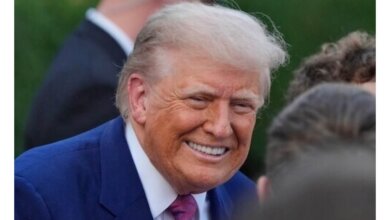U.S. Imposes 15% Tariff on South Korean Goods in Landmark Trade Deal: $450 Billion in Investments Pledged
Washington/Seoul: In a move that significantly reshapes bilateral economic relations, the United States today announced a landmark trade agreement with South Korea, featuring a 15% tariff on South Korean goods — notably vehicles — while allowing U.S. exports into South Korea duty-free. The deal also includes massive South Korean investments in the U.S. economy and a long-term energy purchase plan, signaling deepening economic cooperation between the two allies.
The announcement was made at 10:31 AM IST by U.S. officials and confirmed on President Donald Trump’s Truth Social account. The development follows a wave of tariff escalations on other nations, including Brazil and India, underscoring Washington’s aggressive trade recalibration.
Key Highlights of the U.S.-South Korea Deal
15% Tariff on South Korean Exports: Primarily targeting automobiles and auto parts, the tariff is a reduction from the 25% rate threatened earlier in July.
Zero Tariffs for U.S. Goods: All U.S. exports to South Korea will enter duty-free, enhancing market competitiveness for American industries.
$350 Billion South Korean Investment: This includes $150 billion dedicated to shipbuilding cooperation with U.S.-controlled industries.
$100 Billion U.S. Energy Purchase: South Korea will import liquefied natural gas (LNG) and other energy products from the U.S. over the next 3.5 years.
Additional Investment Announcement Expected: A “large sum” of further South Korean investment is expected to be disclosed during President Lee Jae-myung’s White House visit in two weeks.
Strategic Context and Broader Trade Policy
The South Korea deal comes amid a sweeping overhaul of U.S. trade policy under President Trump’s second term. Just a day earlier, the U.S. levied 50% tariffs on Brazil, citing political instability and the prosecution of former President Jair Bolsonaro. Additional 50% tariffs on copper imports are set to take effect tomorrow, August 1, along with significant hikes targeting India, Canada, Mexico, and Australia.
Country/Product Tariff Rate Effective Date Key Reason
Brazil 50% July 30, 2025 Political unrest, Bolsonaro prosecution
Copper (semi-finished) 50% August 1, 2025 Industrial policy realignment
India 25% August 1, 2025 Trade policies, purchases from Russia
Canada 35% August 1, 2025 Drug-related tensions
Mexico 30% August 1, 2025 Migration, narcotics issues
Australia 10% (baseline) August 1, 2025 Potential hike for trade imbalance.
The South Korean deal, in contrast, appears to be a model of diplomatic economic cooperation, aimed at creating long-term strategic alignment and market certainty.
Implications for Industry
While the deal is a win for South Korea’s auto industry, it leaves other sectors — particularly steel, aluminum, and copper — exposed. Tariffs on these materials remain unchanged. South Korea, the world’s sixth-largest steel exporter, had lobbied for broader relief, but the U.S. maintained its protective stance, likely to safeguard its domestic metal industries.
By aligning South Korean auto tariffs with those already in place for Japan and the European Union (15%), the deal also addresses concerns about competitive fairness across U.S. trade partners.
Market Reaction and Business Outlook
Initial market reactions were cautious. Oil prices remained stable, with traders balancing Trump’s tariff moves against a surprise U.S. crude stockbuild. The broader economic outlook, however, remains uncertain amid fears of retaliatory measures and global supply chain disruptions.
Automotive multinational Stellantis, which imports and exports across the Pacific, warned of a $1.7 billion cost impact due to the layered tariffs being rolled out in 2025.
Upcoming discussions between South Korean Foreign Minister Cho Hyun and U.S. Secretary of State Marco Rubio on Thursday are expected to focus on finalizing implementation frameworks and clarifying sector-specific exemptions.


